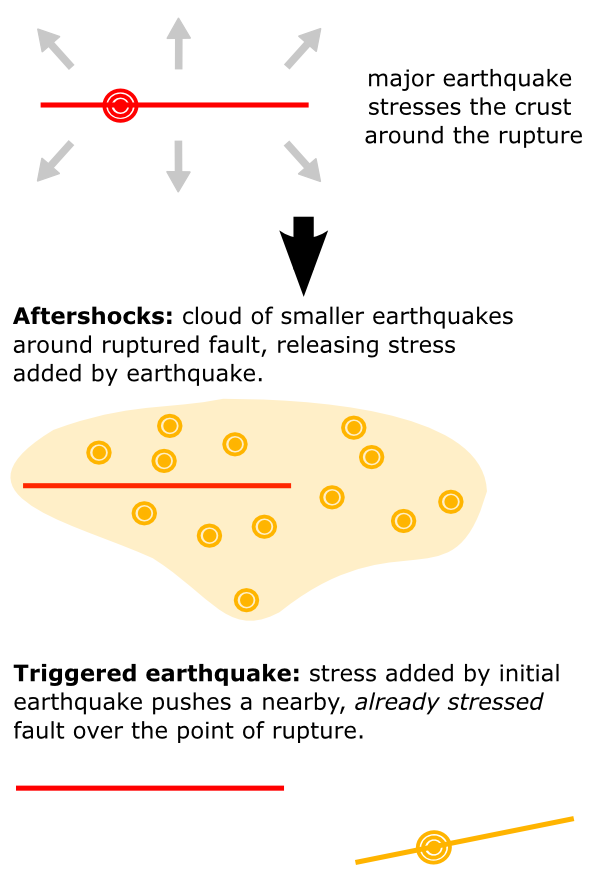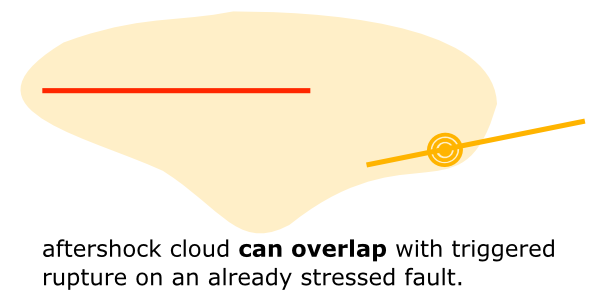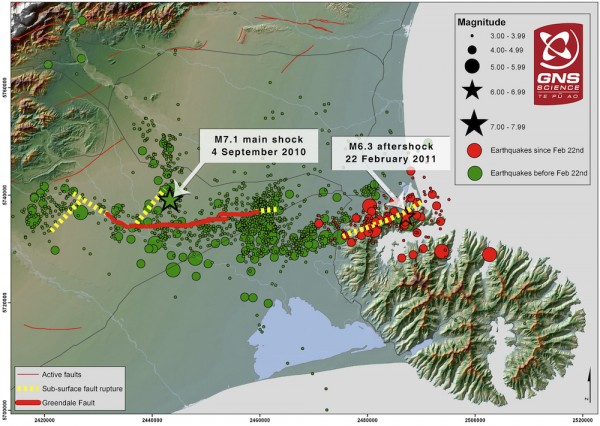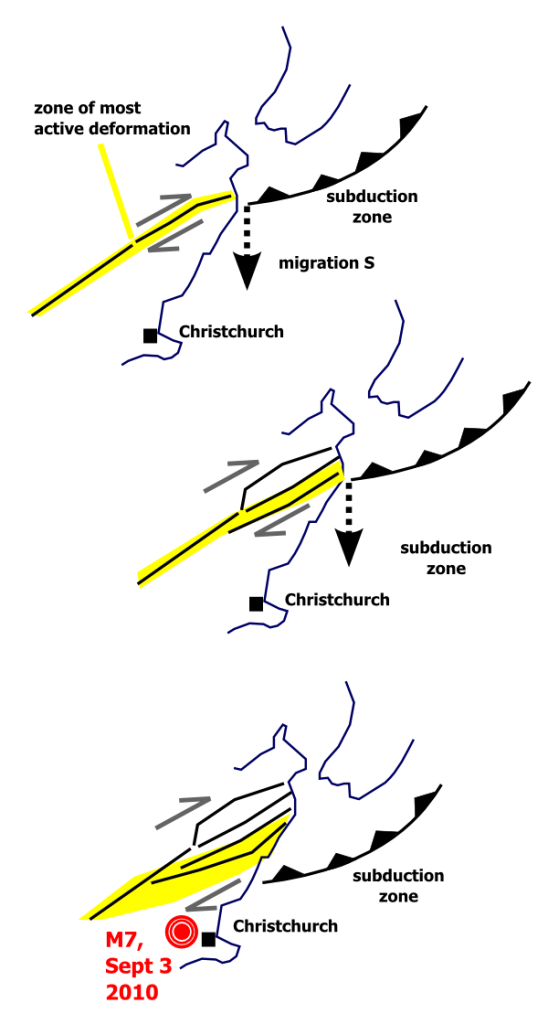![]() As more scientific information becomes available regarding last week’s magnitude 6.3 earthquake in Christchurch, we can look a bit more closely at the nature of this earthquake, how it fits into the overall tectonic picture in New Zealand, and future seismic risks in the region.
As more scientific information becomes available regarding last week’s magnitude 6.3 earthquake in Christchurch, we can look a bit more closely at the nature of this earthquake, how it fits into the overall tectonic picture in New Zealand, and future seismic risks in the region.
Aftershock, or triggered earthquake?
There seems to have been a bit of ambiguity in discussions about the nature of this week’s earthquake: was it an aftershock of September’s earthquake? Was it a separate earthquake that was possibly triggered by September’s earthquake? What’s the difference, anyway?
When any fault ruptures in an earthquake, movement along the fault plane itself also stresses and deforms the the surrounding crust. These stress changes can often induce further smaller earthquakes – aftershocks – that take the form of a cloud of tremors that encompasses the initial rupture. In other words, aftershocks are mainly caused by the stress added to the crust by the initial earthquake. However, very few faults are found in glorious isolation within the crust. More often that not, other faults, that may have themselves accumulated a large amount of tectonic stress over the previous decades and centuries, will be found nearby. In such cases, the stress change due to the first rupture may be large enough to push these nearby faults over the edge, resulting in a triggered earthquake. The difference between this and an aftershock is that the stress added by the first earthquake is only a small component of the stress released when the second fault fails – most of it was already present, and the fault would have ruptured at some point in the future anyway.

The difference between aftershocks and triggered earthquakes.
Where things get complicated is in regions where major faults are quite close to each other – perhaps segments of a large fault boundary fault, or different strands of the same fault system – so that the cloud of aftershocks from a large earthquake on one fault overlaps with the trace of another fault that hasn’t ruptured yet. If that second fault then does rupture, what do we call that? It’s in the same region as all the other aftershocks; but most of the stress being released was not a result of the first earthquake – it was already there on the fault, and the additional loading was just the straw that broke the camel’s back.

When major faults are closely spaced, things can get complicated.
This weeks’ events in New Zealand seem to fall into this ‘it’s complicated’ category. Last September’s Darfield earthquake was centred 40 km to the west of Christchurch, but the epicentres of the aftershocks in the months that followed gradually migrated east towards the city. The map below (courtesy of Geonet) shows that these smaller aftershocks – the green circles – do encompass the area containing the fault which ruptured on Tuesday. So it could – technically – be described as an aftershock. However, for reasons that I discuss below, it seems probable (to me, anyway) that this fault is releasing tectonic stress built up over geological timescales – centuries or more – which would also make this a triggered earthquake. If that is the case, simply referring to it as an aftershock obscures its wider tectonic significance.

All earthquakes in the Christchurch region since September 2010. Earthquakes since 22 Feb 2011 in red. Click to enlarge. Source: Geonet.
The big tectonic picture
And what is that wider tectonic significance? In my discussion of last September’s magnitude 7 earthquake, I wrote the following:
…the occurrence of such earthquakes in this particular region of the South Island is probably also linked to ongoing changes in the nature of the plate boundary at the junction between the subduction zone [off the East Coast of the North Island and the continental transform [The Alpine and Marlborough Faults]. If you look at the displacement history of the individual faults in the Marlborough Fault zone, the northern faults are older, were more active in the geological past, and have quite small recent (in the geological sense of ‘the last few 100,000 years’) displacements; the southern faults are younger, and have much larger recent displacements. The most obvious explanation for these changes is that the most northern of the Marlborough faults was originally directly linked with the end of the subduction zone, but that these two structures moved out of alignment as the subduction zone moved south, causing new strands of the Marlborough Fault system to grow in order to more efficiently accommodate plate motions.
This tectonic evolution is ongoing, and since the end of the subduction zone is now actually to the south of the southernmost and youngest of the Marlborough faults. Some of the plate boundary deformation is probably therefore being shunted into the region around Christchurch, where it needs to be accommodated by dextral strike-slip faulting. Eventually, over geological time, this deformation will lead to the formation of a new, more southerly strand of the Marlborough Fault system.

Growth of new plate boundary faults on the South Island of New Zealand in response to southward propagation of the subduction zone
Looking at the traces of the Darfield Fault, and the fault that ruptured this week, mapped out the Geonet aftershock plot above, it looks to me like two strands of the same, mainly strike-slip, fault system, which is exactly what you would expect for the early stages of a new branch of the Marlborough Fault. Over geological time, then, you would expect to see these faults developing into a much more prominent part of the plate boundary zone. But that’s over the next couple of million years. What about the next few decades?
The future seismic risks for Christchurch
People in Christchurch are unsurprisingly feeling a little overwhelmed by the recent seismic chaos, and fearful for the future. Now that New Zealand geologists have been made aware of the active faults running across the Canterbury Plains, they will be racing to study them and their past behaviour, in order to assess how much risk they pose to Christchurch in the decades and centuries ahead. But the very fact that these faults were unknown actually provides us with some information about them – namely, that although they are active, they have not been particularly active in the recent past. Earthquake-generating faults are identified from the historical record – quite short in the case of New Zealand – and looking for features of the landscape that indicate fault motion, such as scarps and uplifted terraces. The fact that these faults don’t seem to have generated such features, and have instead managed to be totally buried beneath the river-borne debris coming off the uplifted Southern Alps to the west, tells us that these faults do not rupture particularly frequently; if they were, the Canterbury Plains would not be so flat.

Not a particularly tectonically shaped landscape (mountains not included, obviously)
This makes sense: we know how much motion occurs across the plate boundary that bisects New Zealand, and we know that the motion on the main boundary faults of the South Island – the Alpine and Marlborough Faults – accounts for around 80% of that motion. The remainder is probably distributed across many faults on the South Island, not just the ones near Christchurch, which means that they need much longer to build up enough stress to rupture in an earthquake – probably the high hundreds, or low thousands of years. It would be unwise to relax before some detailed geological work is done, of course, but I suspect that these particular faults have done all the damage that they are going to do to Christchurch for the foreseeable future.



Comments (10)
Links (4)-
-
-
-
Pingback: Magnitude 6.3 earthquake rocks Christchurch | Highly Allochthonous
Pingback: Aftershocks in Christchurch « The Trembling Earth
Pingback: Aftershocks of the Sendai earthquake | Highly Allochthonous
Pingback: A fresh temblor in the Canterbury sequence « The Trembling Earth